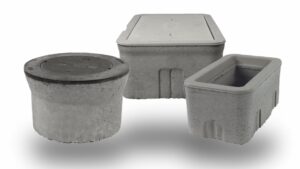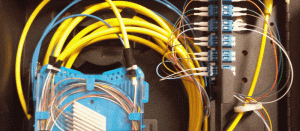5G networks promise to connect people and things through intelligent networks and applications, all generating an immense amount of data. It seeks to provide the best of all performance factors while simultaneously connecting more devices.
These network advancements will enable and inspire a new wave of computing and technological innovation that will change the way we live and work. But before 5G becomes a reality, the network infrastructure has to be in place to support the billions of devices and the trillions of megabits of data that will flood the network.
Let’s take a look at how 5G networks will impact optical-fiber requirements.
Cellular capabilities started off rather simply, but as each generation expanded functionality, applications, and services the network infrastructure supporting them has grown increasingly complex.
To achieve all that 5G offers, a denser, fiber-rich network infrastructure will be needed to deliver the key performance indicators: lower latency, longer battery life, higher data rates, ultra-high reliability and more connected devices.
WHY 5G IS DIFFERENT
5G networks enable the vision of a truly connected society with its impact being felt across virtually every industry. The Internet of Things (IoT) will transform the economy and the way we live our lives. 5G will similarly change and create new economic opportunities.
- 5G smart buildings/cities/communities will provide more efficient services to citizens, increase collaboration among different economic sectors, and encourage innovative business models in both private and public sectors.
- In health care, 5G networks will enable virtual medicine to substantially increase the effectiveness of preventative care, as well as robotic surgery.
- Autonomous vehicles will help make transportation safer, parking easier, and improve traffic flow and congestion.
The opportunities above depend heavily on real-time data, and the need for lower latency and higher bandwidth becomes much more critical. This, in turn, drives the need for edge computing to enable critical data to be transferred quickly.
The early development of cellular networks leveraged macro towers using lower-wavelength spectrum capable of covering wide physical areas, positioning some up to 25 miles apart (if topology allowed).
Towers, however, couldn’t be placed everywhere, and small cells and radio heads were increasingly deployed to get the radio closer to the user. As small cells began to augment coverage and capacity in both 3G and 4G deployments, the term “densification” was introduced.
With 5G, unlike its predecessors, a different set of frequencies will be used in order to implement new services. Sub-6-GHz will be used worldwide as the basis for citywide mobile connectivity, while higher parts of the spectrum (millimeter wave frequencies of 24 GHz and above) will be used for high-bandwidth coverage.
This new higher-band spectrum inherently has more significant distance coverage limitations. Thus, densification takes on an entirely new meaning.
Optical fiber is the preferred medium for existing wireless backhaul networks, and even in networks where this is not the case, the wireless backhaul eventually needs to connect into a fiber backhaul.
Fiber will also be preferred for what is known as “fronthaul,” connecting the dense mesh of 5G small cells. Why is this? Increased speeds with lower attenuation, immunity to electromagnetic interference, small size, and virtually unlimited bandwidth potential are among the many reasons why fiber is the right choice.
The question becomes, “How many fibers are needed to support each cell?” And the answer depends primarily on what technology protocols will be employed.
Using our 60-cells-per-square-mile example, some estimates suggest 8 miles of fiber cable would be needed to connect them. But wait, we need more information …
Today, many operators are using the Common Public Radio Interface (CPRI) protocol for radio heads on macro towers to support a wide variety of cellular services (2G, 3G and 4G/LTE).
Traditionally, each sector and each band received a dedicated pair (one fiber each for transmitting and receiving data); operators could drop 24 or 36 fibers at a cell site and feel confident they had room to grow capacity at that location.
Operators will need to decide on retaining point-to-point dedicated networks and protocols or opting to employ wave division multiplexed (WDM) solutions to lower the fiber count needs.
With a WDM solution, the same macro tower previously described could be serviced with only two fibers. There are tradeoffs with either method, and individual circumstances may lead to different decisions.
With the densification of small cells growing (not only for future 5G networks’ needs but also for existing 3G and 4G needs), the proliferation of optical fiber and connection points along these networks will grow at a rapid rate.
If an operator chooses to service a small cell site with one, two, or twelve fibers, how does it really impact the cost? One thing we know for sure in the deployment of networking infrastructure is that adding more physical capacity at the onset is far less expensive than coming back to add an overlay.
The incremental increase in costs when the fiber count per cell increases isn’t nearly as dramatic as you might expect. The cost increase to jump from one fiber to twelve fibers is under ten percent.
Operators are trending toward a converged approach in the outside plant where wireless networks overlay with wired deployments. We’ve seen it in the metro for years, and now fiber-to-the-home builds are being merged with wireless densification initiatives.
Driven by the cycle of consumer demand, new applications, and bolstered infrastructure, fiber demand continues to spiral upward.
TAKING IT INDOORS
5G networks aren’t just for the outdoors—its impact will be felt indoors as well. 5G will “break” a lot of distributed antenna system (DAS) networks, as the antenna placement will need to be closer than in 3G and 4G deployments.
Additionally legacy copper-based infrastructures won’t be able to keep up with 5G bandwidth. To keep up, smart buildings will undergo their own fiber-in-the-horizontal transformation.
Remember when you lost all signal as the elevator doors closed? With the majority of today’s cellular traffic occurring indoors, many buildings have upgraded their cellular coverage so that those incidents are now few and far between.
DAS and small cells have enhanced cellular in-building and large public venue coverage based on consumer demands for seamless connectivity. In fact, wireless is now often referred to in the industry as the fourth utility, as important to a building as water, electricity, or HVAC. This trend will only continue as the thirst for consumer connectivity continues.
That’s not all. We only briefly touched on the IoT, but imagine again sensors and devices on nearly all the “things” making them smart: utilities and lighting, refrigerators, trash cans, security systems, parking garages, etc.
Add in wearables and augmented reality and you can begin to see the possibilities both indoors and out.
5G will most certainly be an evolution of today’s networks, but the impact will likely be even more significant. Beyond being evolutionary, 5G is potentially revolutionary. The possibilities are virtually unlimited, but a smart, fiber-deep infrastructure will be paramount to making the vision real.










